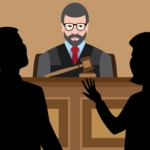 Some attorneys view oral argument as a mere formality, particularly in courts where judges actually read party briefs in advance. Counsel may think, “what can a few minutes of argument add to what a judge has already learned from reading pages-and-pages of my well researched, highly-persuasive brief?”
Some attorneys view oral argument as a mere formality, particularly in courts where judges actually read party briefs in advance. Counsel may think, “what can a few minutes of argument add to what a judge has already learned from reading pages-and-pages of my well researched, highly-persuasive brief?”
But, as wise lawyers know, oral argument can effectively shape the bench’s impression of a case in ways a brief just can’t. Oral argument before the Supreme Court – given the potential impact a ruling can have on counsel’s case and career – is not to be taken lightly. If an attorney is fortunate enough to have certiorari granted, they may begin perspiring at the thought of arguing before the Honorable Justices and a national press corp.
What follows is a quick look Supreme Court oral argument. For in-depth sources of information for arguing attorneys, consider:
- Making Your Case, the Art of Persuading Judges (by Justice Antonin Scalia);
- Supreme Court Practice (10th ed.); and
- Supreme Court and Appellate Advocacy: Mastering Oral Argument (2nd ed.).
Supreme Court Schedule
- Beginning the first Monday in October, the Court generally hears two one-hour arguments a day, at 10 a.m. and 11 a.m., with occasional afternoon sessions scheduled as necessary. Arguments are held on Mondays, Tuesdays, and Wednesdays in two-week intervals through late April (with longer breaks during December and February).
Courtroom Participants
- Justices – Seated on the Bench in order of seniority with the Chief Justice in the middle, and the others alternating from left to right, ending with the most junior Associate Justice on the far right, as you face the Bench.
- Clerk – Seated to the left of the Bench. The Clerk swears in new members of the Bar before argument.
- Marshal – Seated to the right of the Bench. The Marshal calls Court to order, tapes audio portions of oral argument, and maintains time limitations.
- Marshal’s Aides – Seated behind the Justices. Aides carry messages between the Justices and their law clerks.
- Law Clerks – Seated in chairs flanking the Courtroom on the right.
- Counsel – Seated at tables facing the Bench.
- Audience – Seated on a first-come, first-seated basis behind counsel.
Argument Audio
The audio recordings of oral arguments heard by the Supreme Court are available to the public at the end of each argument week. The Court began audio recording oral arguments in 1955. The recordings are maintained at The National Archives and Records Administration.
Argument Transcripts
The Court’s current Courtroom reporter, Alderson Reporting Company, provides transcripts of oral argument on the same day it is heard.
Interesting Notes
- “Mr.” is only used in addressing the Chief Justice. Others are referred to as “Justice Ginsburg” or “Your Honor.” Counsel should never refer to a Supreme Court Justice as “Judge.”
- Appropriate attire for counsel is conservative business dress in traditional, dark colors (this operates as a “no skirts” rule).
- No personal computers, cell phones, cameras, or other electronic devices are allowed in the Courtroom.
- Media interviews are not permitted in the Court building.
- Handcrafted quill pens are left at counsel’s table as gifts.
- On the lectern there are two lights. When a white light goes on, counsel has five minutes remaining to argue. A red light indicates that the attorney has used all of his or her allotted time.